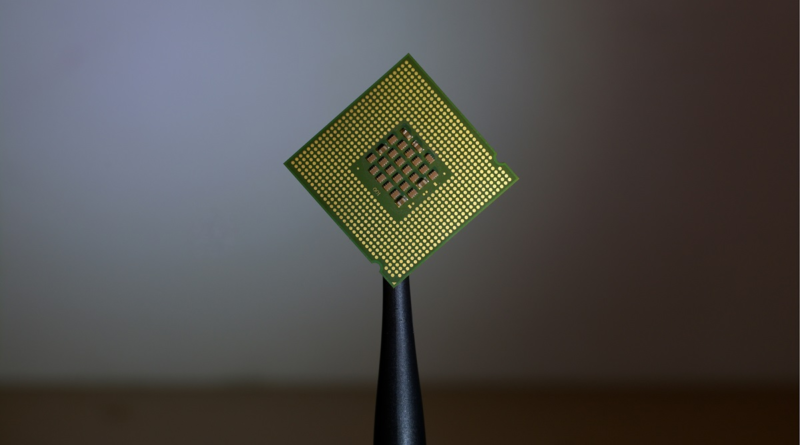3 Chip Stocks for 2024 – Morningstar.ca

Against the backdrop of geopolitical uncertainties, the semiconductor industry appears poised for a rebound in 2024. Shaking off a lackluster performance in 2023, semiconductor manufacturers, are poised to see a jump in revenues, EBITDA margins, and cash flow generation.
“Barring a deep recession, we expect fab manufacturers, especially those involved in manufacturing advanced node chips and memory chips, to have an improved operating environment and better financial metrics leading to enhanced risk profiles,” forecasts Global Semiconductor 2024 Outlook, aMorningstar DBRS report.
The following leading chipmakers are tapped into secular industry trends as demand for AI, data centres, and high-performance computing applications conspire to create a long growth runway for these players.
Global chip heavyweight, Taiwan Semiconductor TSM boasts nearly 60% market share. Its high-profile customers include Apple, AMD and Nvidia, which use the latest technology in their semiconductor designs.
“The company has long benefited from semiconductor firms around the globe transitioning from integrated device manufacturers to fabless designers,” says a Morningstar equity report.
The rise of fabless semiconductor firms – companies that design chips but don’t manufacture them – has been driving the expansion of chip foundries, which has intensified competition.
“However, most of these newer competitors are confined to low-end manufacturing due to prohibitive costs and engineering know-how associated with the leading-edge technology,” points out Morningstar equity analyst Phelix Lee, who puts the stock’s fair value at US$151 per ADR, projects top-line CAGR of 13.5% over the next five years.
Lee identifies two long-term growth factors for TSMC. First, the consolidation of semiconductor firms is expected to create demand for integrated systems made with the most advanced nodes. Second, the organic growth of artificial intelligence, the Internet of Things, and high-performance computing applications may last for decades.
“Even with its dominant market share, the company can deliver above-industry growth through a higher proportion of specialty products, which are currently only produced by Samsung and TSMC at scale,” says Lee, who stresses high-performance computing remains TSMC’s largest growth driver.
Further, increasing in-house design of cloud computing and artificial chips by U.S. and Chinese internet giants will benefit TSMC for the next few years, he adds.
Chipmaker Broadcom AVGO boasts over US$30 billion in annual revenue selling 17 core semiconductor product lines across wireless, networking, broadband, storage, and industrial markets. While it is primarily a fabless designer, the sixth-largest semiconductor company globally does some in-house manufacturing for its best-of-breed FBAR filters that are used in the Apple iPhone.
Broadcom’s high-value chip and software businesses are differentiated and moaty. The firm’s “ability to acquire and streamline generates strong profits and cash flow, and fuels its robust dividend,” says a Morningstar equity report, stressing that its execution and operating efficiency drive the firm’s outperformance.
Networking and wireless chip businesses are Broadcom’s strongest suit and are key contributors to the firm’s sustainable competitive advantage.
The report particularly highlights the chipmaker’s technological lead in thin-film bulk acoustic resonator (FBAR) filters, which it sells exclusively into Apple’s iPhone. FBAR filters are critical components for new 5G-enabled smartphones, as they help boost reception at higher frequencies and extend battery life.
“We don’t foresee a new entrant encroaching on Broadcom’s FBAR prowess and believe it would be difficult even for a rival smartphone chip supplier or for Apple itself,” says Morningstar equity analyst William Kerwin, who puts the stock’s fair value at US$970, and forecasts 15% revenue growth through 2028.
The firm’s steady future growth, he adds, will be driven by data centre networking, Apple unit sales, AI and upselling for its software customers.
Advanced Micro Devices AMD designs semiconductors for PCs, gaming consoles, data centres, industrial, and automotive applications, and others. It also supplies the chips found in popular gaming consoles such as the Sony PlayStation and Microsoft Xbox.
The gip giant’s digital semiconductor expertise positions it well to prosper from favourable secular trends in data centres, AI, and gaming. “We consider AMD to be one of two notable firms in graphics processing units (GPUs), which are especially well suited for AI,” says a Morningstar equity report
While AMD may be lagging Nvidia in AI GPUs, its GPU expertise should become increasingly valuable, and lucrative, in the years ahead, the report adds.
AMD’s partnership with Taiwan Semiconductor gives it a technological edge over Intel, allowing AMD to capitalize on its outsourced manufacturing model. As rival Intel flounders due to its internal manufacturing approach, “AMD will continue to gain market share over the next three years,” says Morningstar equity analyst Brian Colello, adding that AMD could continue to gain for longer if Intel were to stumble further.
Also, given the growing demand for AMD’s server CPUs and GPUs, suited for AI workloads, the company’s “data center business should boom over the next few years,” says Colello, who appraises the stock to be worth US$145.
While Nvidia may capture the bulk of the total addressable market for AI accelerators, estimated to be US$150 billion by 2027, AMD may benefit when AI vendors and customers seek alternatives to keep Nvidia’s dominance in check, Colello notes.
Short seller Muddy Waters alleged manipulation in its asset values. We don’t disagree, b…
These technology companies have been trimming staff to protect profits.
These 7 undervalued energy stocks look attractive today.
These companies are innovating to compete in a cosmetic industry poised to reach US$750 billion b…
Undervalued by more than 30%, the stock of this wide-moat company looks like a bargain to us.
As interest rates head lower, these stocks provide solid dividends and growth potential.
As recently happened to a Franklin Templeton fund, a Canadian mutual fund trust can cease to be, …
This is the math behind the US equity market’s surprisingly-strong performance
These common investing errors could cost you.
A series of strategic spinoffs has left GE a more focused company.
Vikram Barhat A Toronto-based financial writer specializing in investing, stock markets, personal finance and other areas of the financial services industry, Vikram also writes for CNBC, BBC, The Globe and Mail, and Toronto Star.
About Us
Connect With Us
Get Help
Terms of Use Privacy Policy Disclosures Accessibility
The Morningstar Star Rating for Stocks is assigned based on an analyst’s estimate of a stocks fair value. It is projection/opinion and not a statement of fact. Morningstar assigns star ratings based on an analyst’s estimate of a stock’s fair value. Four components drive the Star Rating: (1) our assessment of the firm’s economic moat, (2) our estimate of the stock’s fair value, (3) our uncertainty around that fair value estimate and (4) the current market price. This process culminates in a single-point star rating that is updated daily. A 5-star represents a belief that the stock is a good value at its current price; a 1-star stock isn’t. If our base-case assumptions are true the market price will converge on our fair value estimate over time, generally within three years. Investments in securities are subject to market and other risks. Past performance of a security may or may not be sustained in future and is no indication of future performance. For detail information about the Morningstar Star Rating for Stocks, please visit here
Quantitative Fair Value Estimate represents Morningstar’s estimate of the per share dollar amount that a company’s equity is worth today. The Quantitative Fair Value Estimate is based on a statistical model derived from the Fair Value Estimate Morningstar’s equity analysts assign to companies which includes a financial forecast of the company. The Quantitative Fair Value Estimate is calculated daily. It is a projection/opinion and not a statement of fact. Investments in securities are subject to market and other risks. Past performance of a security may or may not be sustained in future and is no indication of future performance. For detail information about the Quantiative Fair Value Estimate, please visit here
The Morningstar Medalist Rating is the summary expression of Morningstar’s forward-looking analysis of investment strategies as offered via specific vehicles using a rating scale of Gold, Silver, Bronze, Neutral, and Negative. The Medalist Ratings indicate which investments Morningstar believes are likely to outperform a relevant index or peer group average on a risk-adjusted basis over time. Investment products are evaluated on three key pillars (People, Parent, and Process) which, when coupled with a fee assessment, forms the basis for Morningstar’s conviction in those products’ investment merits and determines the Medalist Rating they’re assigned. Pillar ratings take the form of Low, Below Average, Average, Above Average, and High. Pillars may be evaluated via an analyst’s qualitative assessment (either directly to a vehicle the analyst covers or indirectly when the pillar ratings of a covered vehicle are mapped to a related uncovered vehicle) or using algorithmic techniques. Vehicles are sorted by their expected performance into rating groups defined by their Morningstar Category and their active or passive status. When analysts directly cover a vehicle, they assign the three pillar ratings based on their qualitative assessment, subject to the oversight of the Analyst Rating Committee, and monitor and reevaluate them at least every 14 months. When the vehicles are covered either indirectly by analysts or by algorithm, the ratings are assigned monthly. For more detailed information about these ratings, including their methodology, please go to here
The Morningstar Medalist Ratings are not statements of fact, nor are they credit or risk ratings. The Morningstar Medalist Rating (i) should not be used as the sole basis in evaluating an investment product, (ii) involves unknown risks and uncertainties which may cause expectations not to occur or to differ significantly from what was expected, (iii) are not guaranteed to be based on complete or accurate assumptions or models when determined algorithmically, (iv) involve the risk that the return target will not be met due to such things as unforeseen changes in changes in management, technology, economic development, interest rate development, operating and/or material costs, competitive pressure, supervisory law, exchange rate, tax rates, exchange rate changes, and/or changes in political and social conditions, and (v) should not be considered an offer or solicitation to buy or sell the investment product. A change in the fundamental factors underlying the Morningstar Medalist Rating can mean that the rating is subsequently no longer accurate.
For information on the historical Morningstar Medalist Rating for any managed investment Morningstar covers, please contact your local Morningstar office.
For more detailed information about conflicts of interest, including EU MAR disclosures, please see the “Morningstar Medalist Rating Analyst Conflict of Interest & Other Disclosures for EMEA”here


